
|
|
Font Size:
|
||||
|
|
|
|
||||
STATISTICAL BRIEF #293:
Trends in the Pharmaceutical Treatment of Diabetes: A Comparison of Utilization and Expenditures, 1997 to 2007
Highlights
- The proportion of persons with diabetes using oral medications increased from 59.9 percent in 1997 to 77.3 percent in 2007, while the proportion of persons with diabetes using insulin dropped from 38.2 percent in 1997 to 24.4 percent in 2007.
- From 1997 to 2007, prescribing trends were shifting away from sulfonylureas towards the use of biguanides and thiazolidinediones.
- The proportion of persons who used the three most commonly prescribed oral anti-diabetic medications in 1997 and 2007 are as follows: sulfonylureas (51.2 and 40.2 percent), biguanides (21.2 and 55.2 percent), and thiazolidinediones (4.7 and 24.6 percent).
- The average expenditure per user on prescribed anti-diabetic medications for 2006-2007 ($944) were nearly twice that in 1997-1998 ($500, in 2007 dollars). The average out-of-pocket expenditure on anti-diabetic medications in 2006-2007 was $273 compared with $221 in 1997-1998.
Introduction
Diabetes is a chronic and progressive disease associated with significant morbidity, mortality, and costs. Generally, individuals diagnosed with type 1 diabetes rely on insulin while persons with type 2 diabetes follow a stepwise treatment approach to reach the recommended treatment goal of HbA1c < 7 percent. Currently, medical consensus guidelines1 recommend that persons diagnosed with type 2 diabetes initially start with lifestyle modifications plus metformin and subsequently add other oral medications, insulin, or non-insulin injectables if treatment goals are not achieved.2In this Statistical Brief, we present estimates based on data from the Household Component of the Medical Expenditure Panel Survey (MEPS-HC) on trends from 1997 to 2007 in anti-diabetic medication use and expenditures in the U.S. civilian noninstitutionalized population. The sample is composed of persons with diagnosed diabetes (ICD-9-CM codes 249, 250) who reported treatment for diabetes during the year. Trend data are provided for oral medications, insulin, and non-insulin injectables, as well as the subclasses of oral medications. Results presented for drug expenditures are estimated using pooled data for 1997-1998 and 2006-2007. Drug expenditures for all years are expressed in constant dollars, by inflating them to 2007 U.S. dollars using the Consumer Price Index for All Urban Consumers (CPI-U). All differences between estimates discussed in the text are statistically significant at the 0.05 level or better.
Findings
Among persons reporting treatment for diabetes, the proportion who reported cardiovascular disease increased from 13.1 percent in 1997 to 17.2 percent in 2007. Similarly, among persons reporting treatment for diabetes the proportion who reported hypertension increased from 46.1 to 64.8 percent while the proportion who reported hyperlipidemia more than tripled from 15.0 percent in 1997 to 52.8 percent in 2007 (figure 1).Between 1997 and 2007, the total number of persons with diabetes who reported using oral anti-diabetic medications more than doubled, from 5.9 million to 14.6 million. In 1997, 3.7 million persons who reported treatment for diabetes were using insulin compared with 4.6 million in 2007. The proportion of persons with diabetes who used oral anti-diabetic medications increased from 59.9 percent in 1997 to 77.3 percent in 2007. By contrast, the proportion using insulin dropped from 38.2 percent in 1997 to 24.4 percent in 2007. The proportion of persons using non-insulin injection was 4.1 percent in 2007 (figure 2).3
Among persons reporting treatment for diabetes, the total number of persons who used the three most commonly prescribed oral anti-diabetic medications in 1997 and 2007 are as follows: sulfonylureas (5.0 and 7.6 million), biguanides (2.1 and 10.4 million), thiazolidinediones (0.5 and 4.6 million). Sulfonylureas (51.2 percent) were the most widely used class of oral anti-diabetics in 1997 compared to biguanides (21.2 percent) or thiazolidinediones (4.7 percent). By 2007, the proportion of persons treated with sulfonylureas had declined to 40.2 percent compared with an increase in the percentage of persons with diabetes using biguanides (55.2 percent) or thiazolidinediones (24.6 percent) (figure 3).
The mean out-of-pocket expenditure on prescribed anti-diabetic medications (in constant dollars) in 2006-2007 was $273 compared with $221 in 1997-1998. The mean out-of-pocket expenditure on insulin nearly doubled, rising from $132 in 1997-1998 to $257 in 2006-2007. During the same period, mean out-of-pocket expenditures on thiazolidinediones rose from $190 in 1997-1998 to $250 in 2006-2007. In contrast, out-of-pocket expenditures on sulfonylureas and biguanides fell from $167 and $174 in 1997-1998 to $89 and $116 in 2006-2007, respectively. In 2006-2007, out-of-pocket expenditures on non-insulin injections and combination anti-diabetic medications were $258 and $179, respectively (figure 5).
Data Source
The estimates presented in this Statistical Brief were derived from the 1997 and 2007 MEPS Full Year Consolidated Data Files and the 1997 and 2007 MEPS Prescribed Medicines (PMED) Files. Anti-diabetic therapeutic subclass and sub-subclasses were identified by linking the PMED files to the Multum Lexicon. For additional information on the Multum Lexicon database, please refer to the following Web site: http://www.multum.com/Lexicon.htm.Definitions
Persons with diabetes and diabetes-related conditions: Individuals with diabetes and related complications/comorbidities were identified using the 1997 through 2007 MEPS Condition Files and the three-digit ICD-9-CM diagnosis condition variable (ICD9CODX) to construct indicator variables for specified conditions.Persons reporting treatment for diabetes: We identified persons who reported treatment for diabetes within our sample by tying the diabetes diagnosis to reported health services utilization (i.e., home health, inpatient hospital stays, outpatient, office-based, emergency room visits, and prescribed medicines) for the condition during the year.
Anti-diabetic medications: Each drug that was listed as purchased or otherwise obtained in the PMED files was assigned to a major therapeutic class by linking the PMED file to the Multum Lexicon database, a product of Cerner Multum, Inc. The Multum therapeutic classification system is designed to replicate the type of organizational schemes used in practice by physicians and pharmacists. This information was used to identify the three major therapeutic classes of anti-diabetic medications considered in the report: orals (sulfonylureas, biguanides, thiazolidinediones, meglitinides, alpha-glucosidase inhibitors, dipeptidyl peptidase-4 inhibitors); insulin; incretin mimetics; as well as combinations of oral therapies).
Utilization: Indicator variables were created to identify people who received each of the three major therapeutic classes of anti-diabetic medications, the top three classes of oral anti-diabetic medications and their combinations. If combination therapy was indicated, the drug names were examined and the person was identified as having had each medication comprising the combination therapy. For example, if a person had combination therapy and the agents were of the sulfonylurea and biguanides classes, the person was identified as having had each of the individual oral medications and as having had a combination therapy. Utilization estimates are presented as the proportion of persons receiving each of the classes of anti-diabetic medication.
Expenditures: Expenditures include all amounts paid for each drug purchase from any source including payments by individuals and their families and payments by private insurance, Medicaid, Medicare, and other types of insurance. Payments for over-the-counter drugs, and indirect payments not related to specific medical events such as Medicaid Disproportionate Share and Medicare Direct Medical Education subsidies are excluded from the MEPS total expenditures. Expenditures for each year were adjusted using the Consumer Price Index (CPI) and all estimates in this report are reported in 2007 dollars.
| Conditions | ICD-9-CM Diagnosis |
|---|---|
| Diabetes Mellitus | ICD-9 codes 249, 250 |
| Cardiovascular Disease | ICD-9 codes 412, 413, 414, 427, and 428 |
| Hypertension | ICD-9 code 401 |
| Cerebrovascular Disease | ICD-9 codes 430, 431, 432, 433, 434, 435, 436, and 437 |
| Peripheral Vascular Disease | ICD-9 code 443 |
| Nephropathy | ICD-9 codes 585, 586, and 587 |
| Retinopathy | ICD-9 code 362 |
| Hyperlipidemia | ICD-9 code 272 |
About MEPS-HC
MEPS-HC is a nationally representative longitudinal survey that collects detailed information on health care utilization and expenditures, health insurance, and health status, as well as a wide variety of social, demographic, and economic characteristics for the U.S. civilian noninstitutionalized population. It is cosponsored by the Agency for Healthcare Research and Quality and the National Center for Health Statistics.For more information about MEPS, call the MEPS information coordinator at AHRQ (301-427-1656) or visit the MEPS Web site at http://www.meps.ahrq.gov/.
References
For a detailed description of the MEPS survey design, sample design, and methods used to minimize sources of nonsampling error, see the following publications:Cohen, J. Design and Methods of the Medical Expenditure Panel Survey Household Component. MEPS Methodology Report No. 1. AHCPR Pub. No. 97-0026. Rockville, MD: Agency for Health Care Policy and Research, 1997. http://www.meps.ahrq.gov/mepsweb/data_files/publications/mr1/mr1.shtml
Cohen, S. Sample Design of the 1996 Medical Expenditure Panel Survey Household Component. MEPS Methodology Report No. 2. AHCPR Pub. No. 97-0027. Rockville, MD: Agency for Health Care Policy and Research, 1997. http://www.meps.ahrq.gov/mepsweb/data_files/publications/mr2/mr2.shtml
Cohen, S. Design Strategies and Innovations in the Medical Expenditure Panel Survey. Medical Care, July 2003: 41(7) Supplement: III-5 - III-12.
Suggested Citation
Sarpong, E. and Miller, G.E. Trends in the Pharmaceutical Treatment of Diabetes: A Comparison of Utilization and Expenditures, 1997 to 2007. Statistical Brief #293. September 2010. Agency for Healthcare Research and Quality, Rockville, MD. http://www.meps.ahrq.gov/mepsweb/data_files/publications/st293/stat293.shtmlAHRQ welcomes questions and comments from readers of this publication who are interested in obtaining more information about access, cost, use, financing, and quality of health care in the United States. We also invite you to tell us how you are using this Statistical Brief and other MEPS data and tools and to share suggestions on how MEPS products might be enhanced to further meet your needs. Please e-mail us at mepspd@ahrq.gov or send a letter to the address below:
Steven B. Cohen, PhD, Director
Center for Financing, Access, and Cost Trends
Agency for Healthcare Research and Quality
540 Gaither Road
Rockville, MD 20850
1 The American Diabetes Association (ADA) and the European Association for the Study of Diabetes (EASD) Consensus Guidelines, 2006 (updated 2008).
2 Prior to 1995, sulfonylureas, which were the first class of oral anti-diabetic drugs, were the only noninsulin first-line treatment option for persons diagnosed with type 2 diabetes in the U.S.
3 Non-insulin injections such as exenatide, an incretin mimetic became available in the U.S. in 2005.
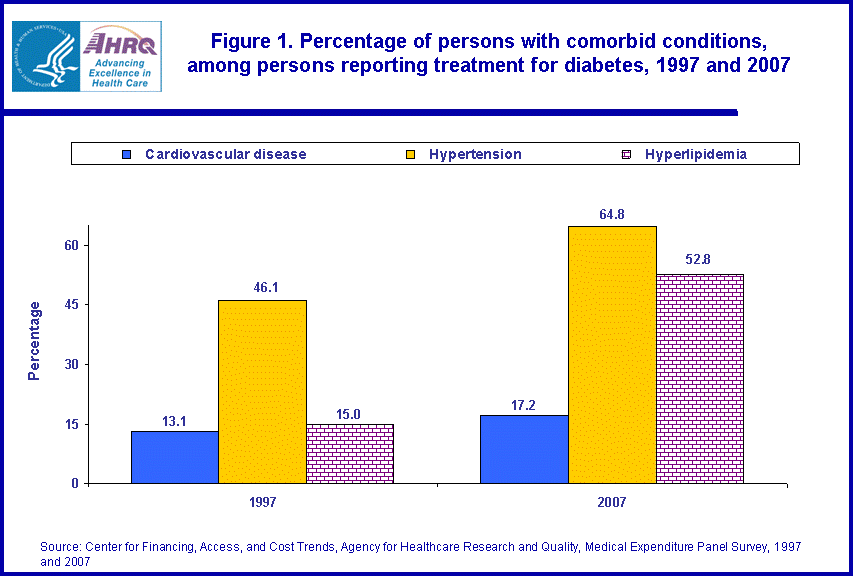 |
||||||||||||||||||||||||||||||
|
||||||||||||||||||||||||||||||
|
|
||||||||||||||||||||||||||||||
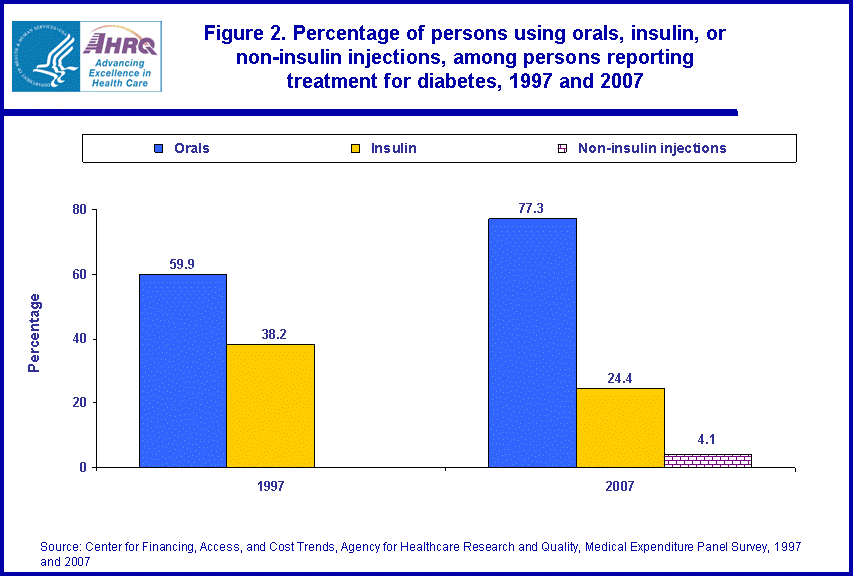 |
||||||||||||||||||||||||||||||
|
||||||||||||||||||||||||||||||
|
|
||||||||||||||||||||||||||||||
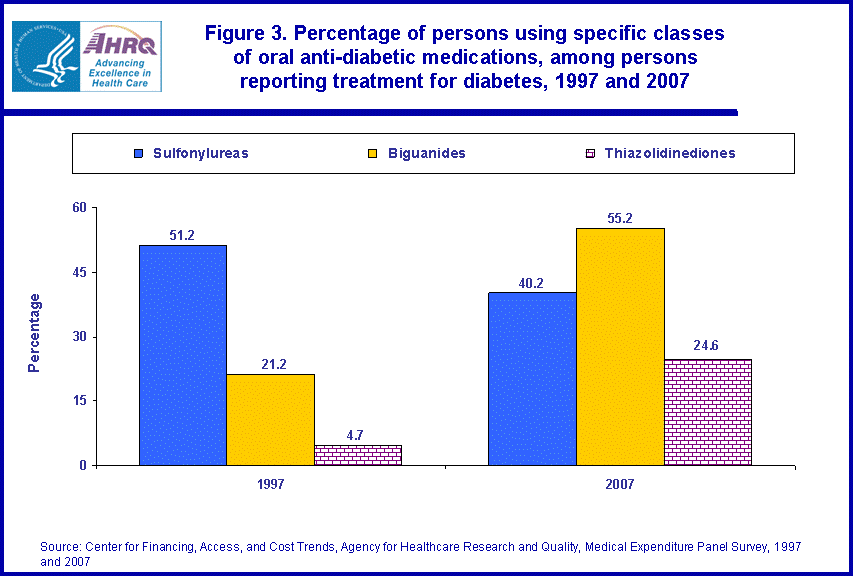 |
||||||||||||||||||||||||||||||
|
||||||||||||||||||||||||||||||
|
|
||||||||||||||||||||||||||||||
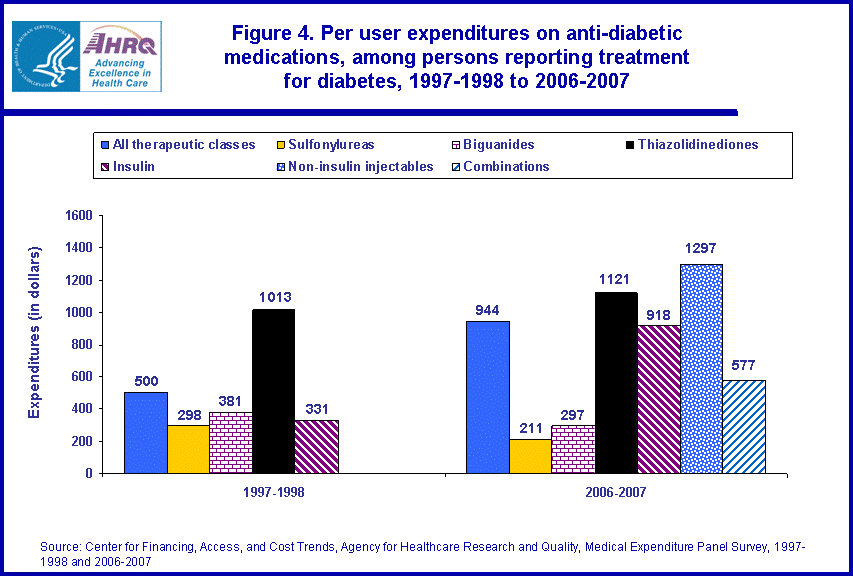 |
||||||||||||||||||||||||||||||
|
||||||||||||||||||||||||||||||
|
|
||||||||||||||||||||||||||||||
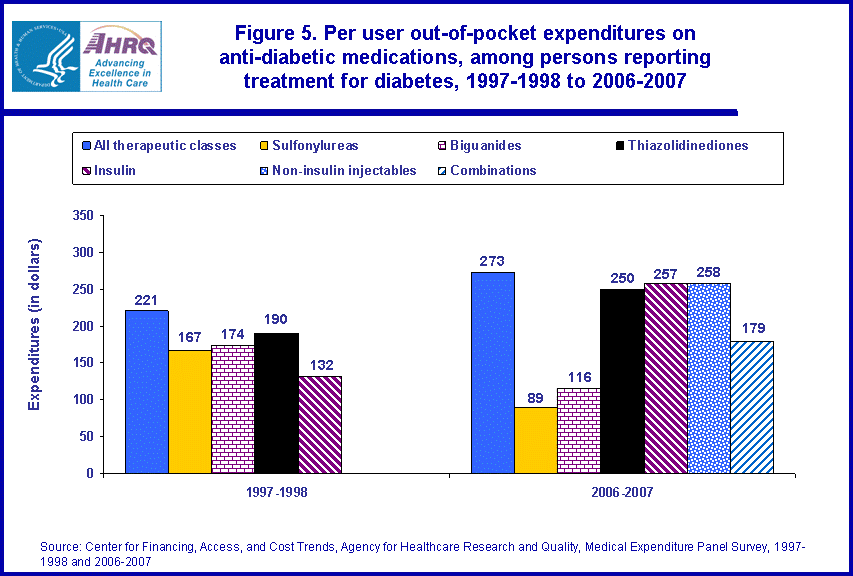 |
||||||||||||||||||||||||||||||
|
||||||||||||||||||||||||||||||
|
|
||||||||||||||||||||||||||||||


